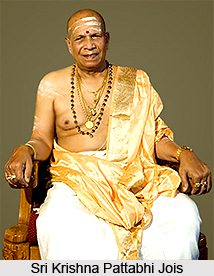 Sri Krishna Pattabhi Jois is the Yoga teacher in India who was the student of Tirumalai Krishnamacharya. He was born on the full moon day of July 26, 1915 that was a Guru Purnima day. His ancestral village was Kowshika, a small village near Hassan in the State of Karntaka. The village was very small having only five hundred people and had only one main street. There are one Ganapati temple and one Shiva temple, both of which are hundreds of years old and they are the main attraction of the village.
Sri Krishna Pattabhi Jois is the Yoga teacher in India who was the student of Tirumalai Krishnamacharya. He was born on the full moon day of July 26, 1915 that was a Guru Purnima day. His ancestral village was Kowshika, a small village near Hassan in the State of Karntaka. The village was very small having only five hundred people and had only one main street. There are one Ganapati temple and one Shiva temple, both of which are hundreds of years old and they are the main attraction of the village.
Sri Krishna Pattabhi Jois was the son of an astrologer, who was also a priest and acted as the `pujari` for many of the families in the village. From an early age K. Pattabhi Jois was taught in Vedas and Hindu rituals as most other Brahmin boys. When K. Pattabhi Jois was twelve years old he attended a yoga demonstration at his middle school in Hassan. The next day he met the great Yoga teacher, T. Krishnamacharya, who had given the demonstration at school. Krishnamacharya learned yoga from his guru Rama Mohan Brahmachari in a cave in Tibet. For the next two years Pattabhi Jois learned yoga from his Guru T. Krishnamacharya every day. When Jois was fourteen years old, he had his Brahmin thread ceremony. Krishnamacharya left Hassan to travel and teach and Jois left his village to go to Mysore.
Pattabhi Jois wanted to study in the Sanskrit University of Mysore and for this purpose he left with two friends with two rupees in his pocket. They traveled over hundreds of kilometers by bike. For the first year or two, life was very difficult. He had little or no money at all and he used to beg for food from any Brahmin houses. But he was strict to attend his classes and did his studies. Then around 1930, Jois went to a Yoga demonstration and found his Guru Krishnamacharya. Pattabhi Jois came forward and prostrated to his Guru. Their relationship recommenced and Jois again joined the Yoga studies.
The Maharaja of Mysore, Krishna Rajendra Wodeyar fall ill. He came to know about the great Yogi, T. Krishnamacharya and asked him to cure him. Maharaja was cured and was very impressed at Krishnamacharya. Maharaja became a great patron of yoga and made one Yogashala on the ground of the place art gallery. Jois was also asked to teach the Maharaja on occasions and was called upon many times to demonstrate Yoga asanas. Maharaja also liked Pattabhi Jois and told him to teach yoga at Sanskrit college. He also offered him scholarship to go to school, free food in his mess hall and a salary. K. Pattabhi Jois was very happy and asked permission from his Guru. Krishnamacharya agreed and the Yoga Department of the Sanskrit College began on March 1, 1937. He continued there until he retired in 1973.
From 1937 to 1973 Krishna Pattabhi Jois earned his professorship at the university, which granted him the title of `Vidvan`. He had a love marriage with Savitramma, who had a glorified scholastic background in Sanskrit. Her grandfather Sri Chandrasekharendra Saraswati was an eminent Sanskrit and philosophy teacher to the last Shankaracharya of Kanchi. They had three children Manju, Ramesh and Saraswati. Saraswati`s son Sarath is now co-director of their school in Mysore.
In the year 1964, Andre Van Lysbeth was the first western people to study with Krishna Pattabhi Jois. Soon after that, other Europeans also came. Around 1972, the first Americans joined after meeting Manju at swami Gitananda`s ashram in Pondicherry. From then on, asthanga Yoga started spreading on America, started from California and then emerged in Hawai. In 1975, Krishna Pattabhi Jois and Manju went to their first trip in America. Over the next 25 years, the practice spread through the United States, France, Germany, Russia, Japan, Israel, Chile, England, Italy, Spain, Switzerland, Canada, Australia, New Zealand, etc. K. Pattabhi Jois taught for 63 years in the same method he learned from his Guru.




















